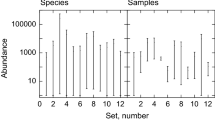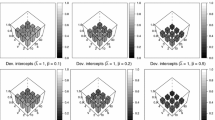Abstract
Testing the ecological communities of different areas for convergence, in the sense of remarkable similarity in the characteristics of the species present, has a long history in biology. Recently, numerical methods have been developed for comparing community-level convergence to an explicit null model.
No valid method has been known for testing the significance of texture convergence when the species are weighted by their abundance. Six combinations of method variants are tested on random datasets. A valid P value (i.e., with P ≤ 0.05 in no more than 5% of the cases) is obtained so long as for each species the distribution of abundances across sites is retained, and only the assignment of character values is randomised. Further restriction is not necessary for obtaining a valid P value, and can lead to a test with considerably lower power to detect convergence. The power of the test with free matching of character values to species is only moderate with 10 sites, though improved with larger numbers of sites.
Previous methods for detecting texture convergence have examined convergence only in the mean value for any character. It is possible that the external environment might be reflected in the community mean of a character, leaving the imprint of convergence on the shape of the distribution, rather than the mean. A method for comparing the shape is described, and it is shown that the null model is valid also for this test statistic.
Similar content being viewed by others
References
Barbour, M.G. and R.A. Minnich. 1990. The myth of chaparral convergence. Israel J. Bot. 39: 453–463.
Barkman, J.J. 1979. The investigation of vegetation texture and structure. In: M.J.A. Werger (ed.), The Study of Vegetation. Junk, The Hague, The Netherlands, pp. 123–160.
Blondel, J., F. Vuilleumier, L.F. Marcus and E. Terouanne. 1984. Is there ecomorphological convergence among mediterranean bird communities of Chile, California, and France? Evol. Biol. 18: 141–213.
Campbell, B.M. and M.J.A. Werger. 1988. Plant form in the mountains of the Cape, South Africa. J. Ecol. 76: 637–653.
Connor, E.F. and D. Simberloff. 1979. The assembly of species communities: chance or competition? Ecology 60: 1132–1140.
Gonzalez, L. and B.F.J. Manly. 1998. Analysis of variance by randomization with small data sets. Environmetrics 9: 53–65.
Hildebrand, M. 1974. Analysis of Vertebrate Structure. Wiley, New York, USA.
Keeley, J.E. 1992. A Californian’s view of fynbos. In: R. M. Cowling (ed.), The Ecology of Fynbos, Oxford University Press, Cape Town, South Africa, pp. 372–388.
Manly, B.F.J. 1996. Are there clumps in body-size distributions? Ecology 77: 81–86.
Pillar, V.D. 1996. A randomization-based solution for vegetation classification and homogeneity testing. Coenoses 11: 29–36.
Pillar, V.D. 1999. On the identification of optimal plant functional types. J. Veg. Sci. 10:631–640.
Schluter, D. 1986. Tests for similarity and convergence of finch communities. Ecology 67: 1073–1085.
Schluter, D. 1990. Species-for-species matching. Am. Nat. 136: 560–568.
Simberloff, D. 1976. Trophic structure determination and equilibrium in an arthropod community. Ecology 57: 395–398
Smith, B., S.H. Moore, P.B. Grove, N.S. Harris, S. Mann and J.B. Wilson. 1994. Vegetation texture as an approach to community structure: community-level convergence in a New Zealand temperate rainforest. N.Z. J. Ecol. 18: 41–50.
Tokeshi, M. 1986. Resource utilization, overlap and temporal community dynamics: a null model analysis of an epiphytic chironomid community. J. Anim. Ecol. 55: 491–506
Watkins, A.J. and J.B. Wilson. 1994. Plant community structure, and its relation to the vertical complexity of communities: dominance/diversity and spatial rank consistency. Oikos 70: 91–98.
Wiens, J.A. 1989. The Ecology of Bird Communities. Vol. 1. Foundations and Patterns. Cambridge University Press, Cambridge, UK.
Wiens, J.A. 1991. Ecomorphological comparisons of the shrub-desert avifaunas of Australia and North America. Oikos 60: 55–63.
Wilson, J.B. 1987 Methods for detecting non-randomness in species co-occurrences: a contribution. Oecologia 73: 579–582.
Wilson, J.B. 1991. Methods for fitting dominance/diversity curves. J. Veg Sci. 2: 35–46.
Wilson, J.B. 1995. Null models for assembly rules: the Jack Horner effect is more insidious than the Narcissus effect. Oikos 72: 139–143.
Wilson, J.B. 1999. Assembly rules in plant communities. In: E. Weiher and P.A. Keddy (eds.), The Search for Assembly Rules in Ecological Communities, Cambridge University Press, Cambridge, UK, pp. 130–164.
Wilson, J.B, Agnew, A.D.Q. and Partridge, T.R. 1994. Carr texture in Britain and New Zealand: Community convergence compared with a null model. J. Veg. Sci. 5: 109–116.
Young, Z. 1981. The Life of Vertebrates. Oxford University Press, Oxford, UK.
Author information
Authors and Affiliations
Corresponding author
Rights and permissions
About this article
Cite this article
Wilson, J.B., Smith, B. Methods for testing for texture convergence using abundance data: a randomisation test and a method for comparing the shape of distributions. COMMUNITY ECOLOGY 2, 57–66 (2001). https://doi.org/10.1556/ComEc.2.2001.1.7
Published:
Issue Date:
DOI: https://doi.org/10.1556/ComEc.2.2001.1.7




